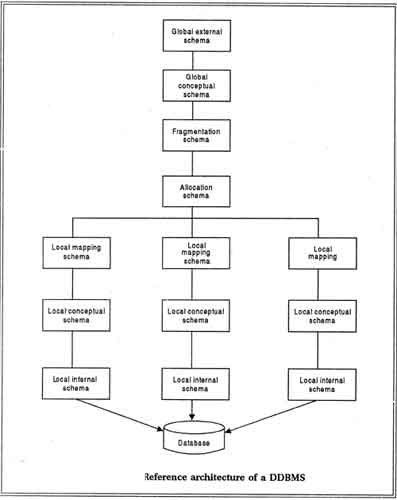Function of a DDBMS
We expect a DDBMS to have at least the functionality for a centralized DBMS. In addition, we expect a DDBMS to have the following functionality:
- Extended communication services to provide access to remote sites and allow the transfer of queries and data among the sites using a network.
- Extended system catalog to store data distribution details.
- Distributed query processing, including query optimization and remote data access.
- Extended security control to maintain appropriate authorization/access privileges to the distributed data.
- Extended concurrency control to maintain consistency of replicated data.
- Extended recovery services to take account of failures of· individual sites and the failures of communication links.
Architecture for a DDBMS
The ANSI-SPARC three-level architecture for a DBMS provides reference architecture for a centralized DBMS. Owing to the diversity of distributed DBMSs, it is much more” difficult to present an equivalent architecture that is generally applicable. However, it may be useful to present one possible reference architecture that addresses data distribution. The reference architecture shown in figure consists of the following schemas:
• A set of global external schemas;
• A global conceptual schema;
• A fragmentation schemas and allocation schema;
The edges in this figure represent mapping between the different schemas.
Global Conceptual Schema
The global conceptual schema is a logical description. of the whole database, as if it were not distributed. This level corresponds to the conceptual level of the ANSI-SPARC architecture and contains definitions of entities, relationships, constraints, security and integrity information. It provides physical data independence· from the distributed environment. The global external schemas· provide logical data independence.
Fragmentation and allocation schemas
The fragmentation schema is a description of how the data is to be logically partitioned. The allocation schema is a description of where the data is to be located, taking account’ of any replication.
Local Schemas
Each local DBMS has its own set of .schemas. The local conceptual and local internal schemas correspond to the equivalent levels of the ANSI-SP ARC architecture.

The Local mapping schema maps fragments in the allocation schema into external objects in the local database. It is DBMS independent· and is the Basis for supporting heterogeneous DBMSs.
 Dinesh Thakur holds an B.C.A, MCDBA, MCSD certifications. Dinesh authors the hugely popular
Dinesh Thakur holds an B.C.A, MCDBA, MCSD certifications. Dinesh authors the hugely popular